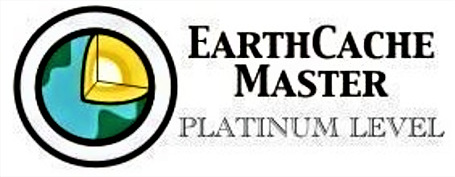This EarthCache is designed to be easy for a beginner, with the lesson focusing on quartz veins found in rocks and how they form.
A “vein” in geology terms refers to a sheet of crystalised minerals within a rock.
A vein can be observed in all types of different rocks, with their dimensions varying wildly in both height and length. Average dimensions range from a few centimetres to a couple of decimetres in height and from a few decimetres to several metres in length.
These veins form in the hotter temperatures under the Earth’s surface, although conditions may vary. These conditions determine the grain structure and textures visible in the vein.
The most common occurrence leading to the creation of a quartz vein is when cracks are already present in the stone. These cracks form most frequently in one of the following ways:
- Folding of a rock during a formation of a mountain
- Shattering during tectonic movements/volcanic movements
- A decrease in pressure during the uplift of a rock
- When a rock cools down and shrinks
Once the cracks have formed, hot magma flows into the rock and transports minerals and other sediments with it, which are eventually deposited into the cracks. Once inside the rock the magma then cools, causing the crystals deposited to be solidified and become part of the rock. This process may continue until the crack is completely filled or may stop beforehand due to a decrease in temperature, leaving pockets in the newly formed veins.
Many other sediments are deposited along with the minerals, including animal remains and igneous rocks formed by the magma (which transported the crystals) cooling down. This can effect the percentage of quartz in the veins.
The formation of a quartz vein is a quick one (in a geological time frame). The result of this is the quartz looking milky, either a singular large crystal or many interlocked milky looking quartz crystals.
Once the the crystals have cooled and the growth has slowed, the crystals appear less milky in texture and some specimens may become clear. However, most retain their milky quality.
Observe all given information and see the questions below to complete this EarthCache.
Logging Requirements:
Look at the stone at the given coordinates and answer the following questions:
- How many quartz vein layers can you see in the rock?
- Are the minerals milky or clear? What does this mean?
- How big are the veins in height? Does it vary?
- What do you think this variation means?
- In a percentage, how much quartz do you think is in the veins? Does it vary by layer?
- Why do you think the layers vary in such a short amount of space?
- Post a picture of yourself, your stamp or personal with the stone in the background.
Please send messages via Geocaching message centre or to my email, answers posted in the logs will be deleted.
You can log the find immediately, if answers are supplied to CO within 14 days.
Happy caching!
I have reached the GSA's highest level:

